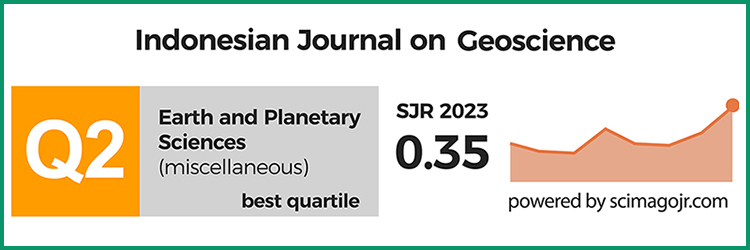Kondisi Permukaan Air Tanah dengan dan tanpa peresapan buatan di daerah Bandung: Hasil Simulasi Numerik
DOI:
https://doi.org/10.17014/ijog.4.3.177-188Keywords:
groundwater level, Bandung, artificial recharge, numerical simulationAbstract
https://dx.doi.org/10.17014/ijog.vol4no3.20093
Significant groundwater level drawdown caused by groundwater abstractions has been reported to occur in Bandung and its surrounding area. One potential method to recover the groundwater condi- tion is artifical recharge, considering high quantity of rainfall in this area. In this research, numerical simulation has been performed in order to predict groundwater condition in the next five years, if: 1) no recovery action is taken (do-nothing) (Scenario 1), and 2) artificial recharge is performed (Scenario 2). Hydrogeological condition reconstruction required for physical model development reveals that the main aquifer in the researched area is Cibeureum Formation, which comprises volcanic fans; the main aquitard is Kosambi Formation, crasisting of lake deposit, whilst the hydrogeologic basement in the research area is the Cikapundung Formation, other Quaternary volcanic rocks, except the Cibeureum Formation, and Tertiary rock units. The recharge area is the areas where the Cibeureum Formation crops out. The result of numerical simulation of Scenario 1 shows that if there is no recovery action taken on the groundwater condition, then in year 2013 the Critical Zone will increase about 116 % and the Damage Zone will increase about 570 %. The result of this scenario also shows that there will be groundwater mining in several areas in the Damage Zone with the total area of 244 km2 or 41 % of the total confined aquifer area. Result of the numerical simulation of Scenario 2 shows that the artificial recharge in the above Critical and Damage Zones will effectively recover groundwater condition in year 2013 which means is, the whole area becomes Safe Zone. The amount of the artificial recharge is about 164 million m3/year and it started from year 2009. The artificial recharge means recharge well, surface reservoir, or recharge ditch where the Cibeureum Formation crops out, or injection well where this formation does not crop out.
References
Abidin, H.Z., Andreas, H., Gamal, M., Wirakusumah, A.D., Darmawan, D., Deguchi, T., dan Maruyama, Y., 2008. Land subsidence characteristics of the Bandung Basin, Indonesia, as estimated from GPS and InSAR. Journal of Applied Geodesy, 2, h.167-177.
Alzwar, M., Akbar, N., dan Bachri, S., 1992. Peta Geologi Lembar Garut dan Pameungpeuk, Jawa Barat, Skala 1:100.000. Pusat Penelitian dan Pengembangan Geologi Bandung.
BMG, 2002. Data curah hujan daerah Bandung dan sekitarnya.
Dam, M.A.C., 1994. The Late Quaternary Evolution of the Bandung Basin, West Java, Indonesia. Pusat Penelitian dan Pengembangan Geologi - Bandung, 252h.
Distamben Jabar – LPPM ITB, 2002. Penyusunan Rencana Induk Pendayagunaan Air Bawah Tanah di Cekungan Bandung dan Bogor. Laporan Akhir, Distamben Jabar, tidak dipublikasikan, 88h.
Distamben Jabar – LPPM ITB, 2006. Evaluasi Pendayagunaan Air tanah di Cekungan Air tanah Bandung – Soreang dan Cekungan Air tanah Bogor. Laporan Akhir, Distamben Jabar, tidak dipublikasikan, 60h.
DTLGKP, 2001. Cekungan Air Bawah Tanah di Jawa Barat. DTLGKP-Bandung.
DTLGKP dan Distamben Jabar, 2004. Pemantauan Kondisi Air Bawah Tanah Cekungan Bandung – Soreang, Bogor, dan Bekasi – Karawang Tahun 2004. Laporan Akhir, Distamben Jabar, tidak dipublikasikan, 189h.
Harnandi, D., Iskandar, N., dan Nuzulliyantoro, A.T., 2006. Pengelolaan air tanah Cekungan Air tanah Bandung. Buletin Geologi Tata Lingkungan, h.1-6.
Hutasoit, L.M. dan Ramdhan, A.M., 2006. Recharge Area and the Origin of Brackish Water in East Bandung: Result of Exploration Well. Proceedings of International Symposium on Mineral Exploration (ISME) IX, Bandung.
Hutasoit, L.M. dan Ramdhan, A.M., 2009. Analisis data sumur pemboran air tanah di daerah Bandung dan sekitarnya. Geoaplika (dalam persiapan).
Iwaco –Waseco dan PU, 1990. West Java Provincial Water Sources Master Plan for Water Supply, Bandung Hydrological Study. Government of Indonesia, Ministry of Public Works, Jakarta, and Directorate General for Human Settlements, Directorate of Water Supply and Government of the Netherlands, Ministry of Foreign Affair, Directorate General of International Cooperation. Laporan Akhir, Departemen PU, tidak dipublikasikan, 227h.
Koesoemadinata, R.P. dan Hartono, D., 1981. Stratigrafi dan Sedimentasi Daerah Bandung. Proceedings PIT X Ikatan Ahli Geologi Indonesia, Bandung, h.318 - 336.
Kusmono, M., Kusnama, dan Suwarna, N., 1996. Peta Geologi Lembar Sindangbarang dan Bandarwaru, Skala 1 : 100.000. Pusat Penelitian dan Pengembangan Geologi, Bandung.
Priowirjanto, G. dan Marsudi, 1995. Fluktuasi Permukaan air tanah Cekungan Bandung. Prosiding Seminar Sehari Air tanah Cekungan, Bandung.
Silitonga, P.H., 1973. Peta Geologi Lembar Bandung, Jawa Barat, Skala 1:100.000. Pusat Penelitian dan Pengembangan Geologi, Bandung.
Sujatmiko, 2003. Peta Geologi Lembar Cianjur, Jawa Barat, Skala 1 : 100.000. Pusat Penelitian dan Pengembangan Geologi, Bandung.
Soetrisno, 1996. Impacts of Urban and Industrial Development on Groundwater, Bandung, West Java, Indonesia. Makalah dipresentasikan pada Simposium mengenai Air tanah dan Rencana Tata Ruang, Fremantle, Western Australia.
Wibowo, W. dan Repoyadi, P., 1995. Geometri Akuifer dan Potensi Air tanah Cekungan Bandung. Prosiding Seminar Sehari Air tanah Cekungan, Bandung.



















